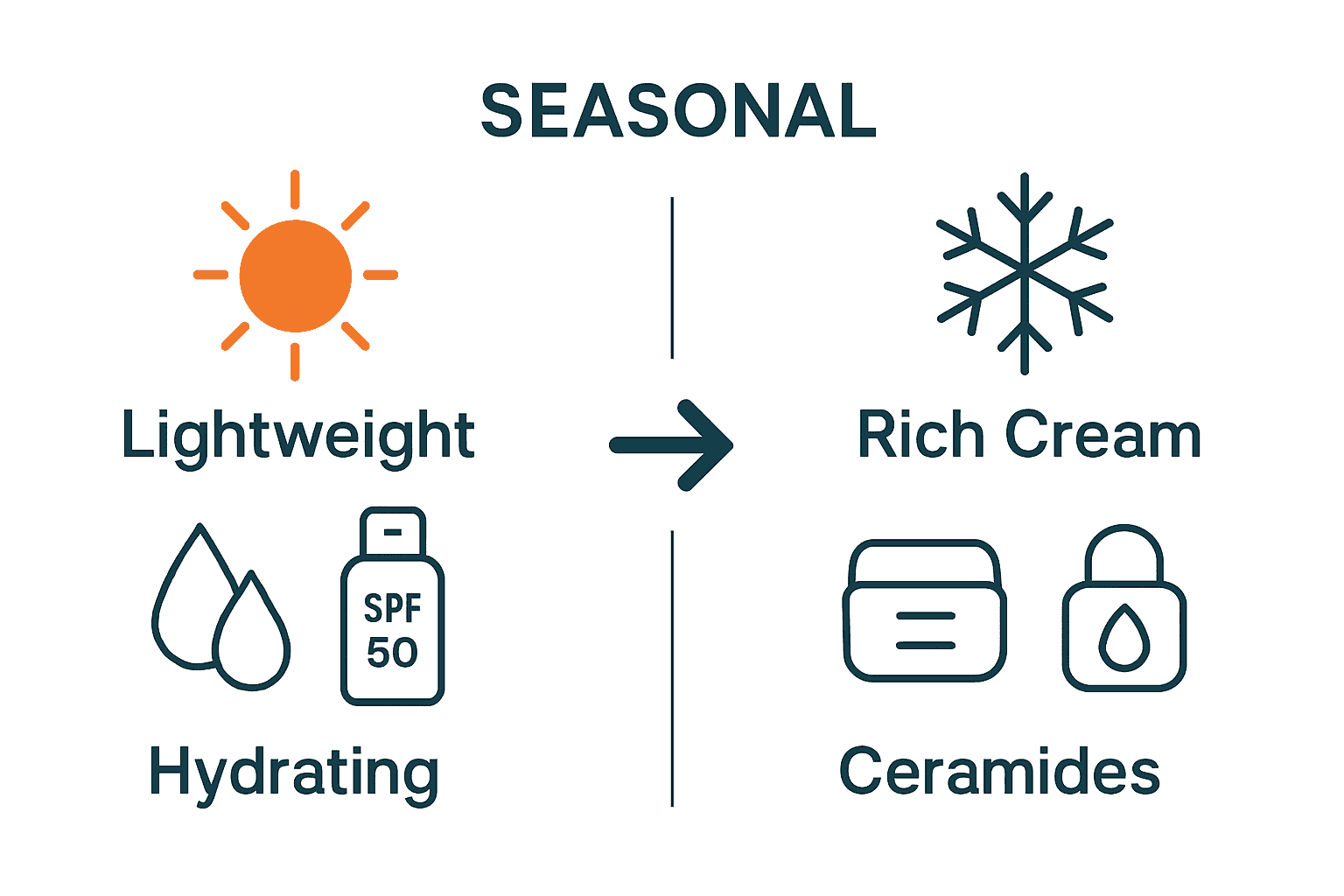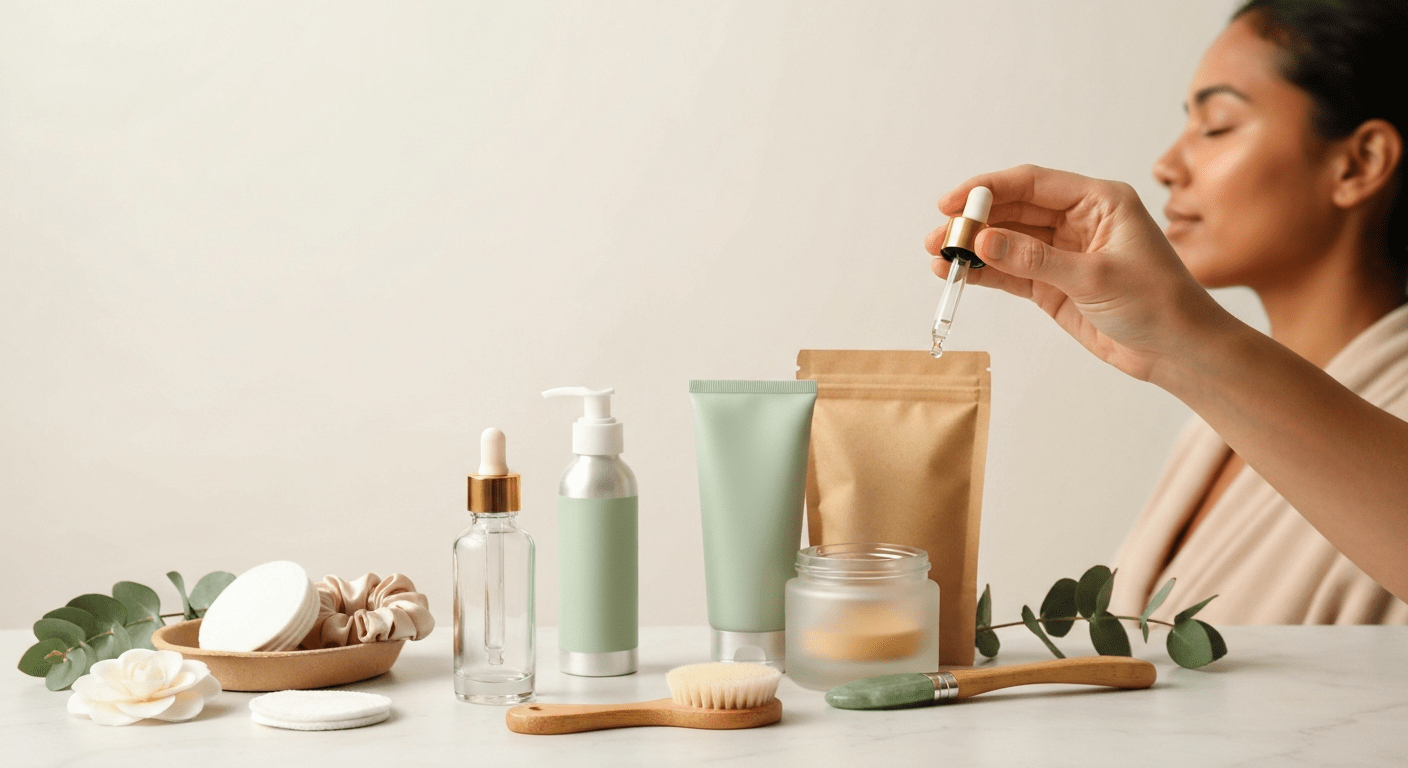Seasonal shifts can cause more than just wardrobe changes. Over 60 percent of people notice their skin feels drier or oilier as temperatures and humidity levels rise and fall. That means your skincare routine may need more than a quick swap or two. Paying close attention to how your skin responds with each season can help you prevent common problems like breakouts or persistent dryness and keep your complexion looking its best year round.
Table of Contents
- Step 1: Assess Your Skin’s Seasonal Changes
- Step 2: Choose Cleanser and Moisturizer for Each Climate
- Step 3: Incorporate Seasonal Treatments and Actives
- Step 4: Adjust Sun Protection and Hydration Methods
- Step 5: Verify Skin Health with Weekly Self-Checks
Quick Summary
| Key Point | Explanation |
|---|---|
| 1. Document Skin Changes Regularly | Keep a skin journal to track seasonal changes and recognize how your skin reacts to various conditions. |
| 2. Tailor Cleansers and Moisturizers | Select lightweight cleansers and moisturizers in summer and richer products in winter to suit your skin’s needs. |
 |
| 3. Rotate Active Ingredients Seasonally | Use summer-friendly actives like niacinamide and vitamin C, while opting for ceramides and peptides in winter. |
| 4. Adjust Sun Protection and Hydration | Use lightweight sunscreens in summer and thicker formulations in winter to protect against sun damage and dryness. |
| 5. Conduct Weekly Skin Health Checks | Perform weekly assessments to monitor skin texture and hydration to identify any issues early and adjust care accordingly. |
|
| 3. Rotate Active Ingredients Seasonally | Use summer-friendly actives like niacinamide and vitamin C, while opting for ceramides and peptides in winter. |
| 4. Adjust Sun Protection and Hydration | Use lightweight sunscreens in summer and thicker formulations in winter to protect against sun damage and dryness. |
| 5. Conduct Weekly Skin Health Checks | Perform weekly assessments to monitor skin texture and hydration to identify any issues early and adjust care accordingly. |
Step 1: Assess Your Skin’s Seasonal Changes
Understanding how your skin responds to different seasonal conditions is crucial for maintaining a healthy skincare routine. Your skin is a dynamic organ that changes its behavior based on environmental factors like humidity, temperature, and sun exposure.
To effectively assess your skin’s seasonal changes, start by observing key indicators. In summer, look for signs of increased oil production such as shinier skin, larger pores, and potential breakouts. During winter, watch for symptoms of dryness like flakiness, tightness, and increased sensitivity. Take notes on how your skin feels and looks throughout different weather conditions.
A practical method for tracking seasonal skin changes involves creating a simple skin journal. Document your skin’s texture, hydration levels, and any emerging concerns every two weeks. Note environmental factors like indoor heating, air conditioning, outdoor temperature, and humidity levels. This systematic approach helps you understand your skin’s unique response pattern. Banish Dry Skin Winter Proof Hydration Toolkit can provide additional insights into managing seasonal skin variations.
Remember that everyone’s skin is different. What works for one person might not work for another, so patience and consistent observation are key to developing a personalized skincare strategy.
Step 2: Choose Cleanser and Moisturizer for Each Climate
Selecting the right cleanser and moisturizer for different climates is essential for maintaining healthy skin throughout the year. Climate-Friendly Skincare Guide can help you understand the nuances of seasonal skincare.
Research from China and Central Europe has demonstrated significant seasonal variations in skin hydration and sebum production PubMed. In summer, opt for lightweight gel cleansers that remove excess oil without stripping your skin. Choose water-based moisturizers with ingredients like hyaluronic acid that provide hydration without feeling heavy. For winter, switch to cream-based cleansers that offer more moisture and nourishment. Select richer moisturizers containing ceramides and fatty acids to protect your skin from cold and dry conditions.
A key strategy is to layer your products strategically. In humid summers, use a gentle foaming cleanser followed by a lightweight serum and gel moisturizer. During dry winters, start with a creamy cleanser, apply a hydrating serum, and finish with a thick cream that locks in moisture.
 Best Organic Moisturizers for Glowing Skin can provide additional guidance on selecting the right products.
Best Organic Moisturizers for Glowing Skin can provide additional guidance on selecting the right products.
Remember that your skin is unique. Pay attention to how it responds to different products and be willing to adjust your routine as needed.
Step 3: Incorporate Seasonal Treatments and Actives
Adapting your skincare treatments and active ingredients to seasonal changes is crucial for maintaining healthy and resilient skin. Scientific research has revealed that different seasons significantly impact skin function and require tailored approaches.
Research on Korean females demonstrated notable seasonal variations in skin hydration, sebum production, and elasticity PubMed. During summer, focus on lightweight active ingredients like niacinamide and vitamin C that help control oil production and protect against sun damage. In winter, shift towards more nourishing treatments with ingredients such as ceramides and peptides that support skin barrier function. Fall Skincare Essentials for a Radiant Glow can provide additional insights into seasonal skincare transitions.
A strategic approach involves rotating your active ingredients based on seasonal needs.
In humid summer months, incorporate gentle chemical exfoliants like salicylic acid to manage excess oil and prevent clogged pores. When winter arrives with its dry conditions, reduce exfoliation frequency and prioritize hydrating and repairing ingredients like hyaluronic acid and panthenol. Always patch test new treatments and introduce them gradually to understand how your unique skin responds to seasonal changes.
Remember that skincare is a personal journey. What works perfectly in one season might need adjustment in another, so stay observant and flexible with your routine.
Step 4: Adjust Sun Protection and Hydration Methods
Protecting your skin from sun damage and maintaining optimal hydration are critical practices that require strategic adjustments throughout different seasons. Your skincare approach must evolve to combat changing environmental conditions.
Research reveals fascinating insights into seasonal skin variations. A scientific study found annual fluctuations in skin conductance and brightness PubMed, highlighting the importance of consistent sun protection regardless of temperature. During summer, opt for lightweight sunscreens with broad spectrum SPF 50 that offer both UVA and UVB protection without feeling heavy. In winter, switch to richer sunscreen formulations that provide additional moisture and create a protective barrier against harsh winds and indoor heating.
When it comes to hydration, adapt your strategy based on seasonal humidity levels. In dry winter months, prioritize deeply hydrating products with ingredients like glycerin and hyaluronic acid to combat increased transepidermal water loss. Winter research indicates nasolabial skin conditions can worsen during colder periods PubMed, so focus on creating a robust moisture barrier. During humid summers, use gel based hydrators that provide lightweight yet effective moisture without feeling greasy. Remember to layer your hydration products starting with lightweight serums and finishing with appropriate moisturizers.
Stay flexible and attentive to your skin’s changing needs throughout the year.
Step 5: Verify Skin Health with Weekly Self-Checks
Weekly skin health assessments are your personal diagnostic tool for understanding how seasonal changes impact your skin. By dedicating a few moments each week to careful observation, you can proactively manage your skincare routine and catch potential issues early. Understanding the Benefits of Daily Skincare can provide additional context for comprehensive skin monitoring.
Research indicates significant seasonal variations in physiological skin characteristics. A scientific study revealed that individuals can detect subtle changes in skin temperature and microvascular blood flow through regular self monitoring PubMed. Establish a consistent weekly ritual where you examine your skin under good lighting. Check for changes in texture, hydration levels, redness, and overall appearance. Pay special attention to areas like your cheeks, forehead, and nasolabial folds that are most sensitive to seasonal shifts.
Create a simple self check routine that includes visual and tactile assessments. Take close up photos in consistent lighting to track changes over time. Note any variations in skin smoothness, emerging dry patches, increased oiliness, or changes in sensitivity. Look for signs like uneven skin tone, emerging fine lines, or changes in skin elasticity. Keep a small journal to document your observations tracking how your skin responds to different seasonal conditions and skincare adjustments.
Remember that your skin tells a story. Listen carefully and respond accordingly.
Master Your Seasonal Skincare with Confidence
Adjusting your skincare routine between summer and winter can feel overwhelming as you face fluctuating humidity and dryness. The challenge is clear: keep your skin balanced and radiant regardless of the season by choosing the right cleansers, moisturizers, and active treatments tailored to changing needs. Many struggle with winter tightness and summer oiliness, but understanding your skin’s unique responses empowers you to act effectively.
Discover how to transform these seasonal skincare challenges into an opportunity for glowing, healthy skin year-round. Whether you need lightweight hydration for summer or rich nourishment for winter, you can find targeted solutions that respond to your skin’s rhythms. At GNS Beauty & Personal Care, we specialize in premium, eco-conscious products designed to promote natural beauty and wellness through every season.

Ready to refresh your routine now? Explore our carefully curated selection and unlock the secrets to effective seasonal skincare today. Visit GNS Beauty & Personal Care to choose your perfect products and embrace your skin’s natural glow with confidence. Learn more from our expert guides like the Banish Dry Skin Winter Proof Hydration Toolkit and Best Organic Moisturizers for Glowing Skin to elevate your ritual immediately.
Frequently Asked Questions
How should I adjust my cleanser for summer versus winter skincare?
To adjust your cleanser for the seasons, opt for a lightweight gel cleanser in summer to manage oil and sweat. In winter, switch to a cream-based cleanser that offers more moisture and nourishment to combat dryness.
What type of moisturizer is best for summer and winter?
In summer, choose a water-based moisturizer with hydrating ingredients like hyaluronic acid to keep your skin light and breathable. During winter, use a richer moisturizer containing ceramides and fatty acids to create a protective barrier against the cold.
How can I tell if my skin needs a different routine for summer or winter?
Pay attention to your skin’s texture and hydration levels; if your skin feels oily and shiny, it needs a lighter routine for summer. Conversely, if your skin feels dry, tight, or sensitive, it’s time to switch to a more nourishing routine for winter.
What specific treatments or active ingredients should I use in summer versus winter?
In summer, incorporate lightweight actives like niacinamide and vitamin C to reduce oiliness and protect against sun damage. For winter, prioritize nourishing treatments with ceramides and peptides that support skin barrier function and hydration.
How often should I check my skin to assess seasonal changes?
Conduct weekly self-checks to monitor your skin’s response to seasonal changes. Examine areas prone to dryness or oiliness, and document your findings to adjust your skincare routine accordingly.
What sun protection measures should I take during summer and winter?
In summer, use a lightweight sunscreen with broad-spectrum SPF 50 for effective protection while keeping your skin light. During winter, apply richer sunscreen formulations that blend moisture and protection to shield against harsh winds and indoor heating.








Hinterlasse einen Kommentar
Alle Kommentare werden vor der Veröffentlichung geprüft.
Diese Website ist durch hCaptcha geschützt und es gelten die allgemeinen Geschäftsbedingungen und Datenschutzbestimmungen von hCaptcha.